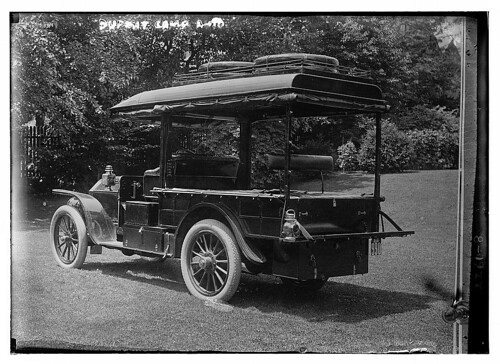
Since this truck advertises a creamery, the reference to "Overman Cushion Tire Co." in the LC caption presumably is to the building in the background and the tires on the truck, but not the truck itself. The LC curator says the photo was made "between 1905 and 1945," but the truck has a license plate for 1920 so the start date is much too early and it's very unlikely the truck was still in commission as late as 1945. A Shorpy commenter says the truck was probably manufactured by the White Motor Company, probably in 1920, and another says it's a White Model 15 from that year.* It's clearly been in use for a couple years or more, so I'd guess the photo to be from 1925-30.
Here are some detailed views.
1. When I first looked at this, I experienced a vivid recall of the complex and distinctive smells that you sense when seated behind the wheel of a 1920s car or truck. I couldn't say what it was that emitted the odors — lubricating oils, the rubber compound on the steering wheel, the leather seat and its padding, or what. But the aroma is pleasant to me, nicely nostalgic.** This front view shows something obvious: apart from the engine and gearbox, there's almost nothing out of view. The design is pretty much as functional as a truck can be. There are no wipers, but upper half of the windshield can either be swung down on a hinge or (apparently) removed entirely as desired. I'd say the creamery that owned the truck didn't use it to haul milk products, but rather something that isn't required to be kept clean.

2. In this shot you can easily see the engine's crank handle and the truck's hard rubber tires, studded wheels, spring suspension, and slightly damaged radiator.

3. The truck is registered in DC as the license plate shows. The radiator cap does not appear to have a pressure release and there is no temperature gauge on it. The fender is a bit crumpled. The side lamps use oil for fuel.

4. There's torn fabric on the bench seat. The brake and shift levers emerge from floorboard. So do the iron brake and clutch pedals. The steering wheel has spark advance. The steering column is a hollow metal rod.

5. There's no glass behind the driver, just a curtain. The roof is properly roof-shaped. Someone has taken the trouble to do some non-functional paint decoration.

6. The slogan shown here contrasts with the ruggedness of the truck itself. The rear "fender" is merely a spray shield. You can see the large beam to which the body is bolted. No one seems to have seen a need for a tailgate latch.

--------------
Notes:
* These photos of White Model 15 trucks from 1920 do indeed look like the one in the LC photo.


** Back when novels contained lots of description, authors would sometimes tell how how things smelled as well as how they looked. That rarely resonated with me and never so intensely as the olfactory memory that this photo calls forth.




No comments:
Post a Comment